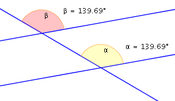Geometry formulary
| This article is a collection of formulas on the subject of geometry . Math symbols are used, which are explained in the article List of Math Symbols . |
The formula collection for Euclidean geometry is part of the formula collection , which also contains formulas from the other departments.
Identifiers and spellings
In the vast majority of cases:
- Points are labeled with Latin capital letters .
- Lines such as straight lines, segments and arcs are labeled with Latin lowercase letters .
- Angles are labeled with lowercase Greek letters .
In the following, angles are given in degrees.
Geometry in the plane
Basics
angle
|

|
|

|
|
|
|
|
|
|
|
Division of a route
Ratio division: In order to divide a line in a certain ratio (into equal parts), one first draws an arbitrary ray from which is not parallel to . On this one can cover any length of distance. Connect the end point obtained with and draw the parallels to through the points created when dividing . Their intersections with parts in equal parts.
Areas and perimeters
The standard name for triangles:
- Cornerstones
- and . The corner is the meeting point of the same sides in the isosceles triangle and the vertex of the right angle in the right triangle .
- pages
- is the side opposite the corner , the same applies to and . In the case of an equilateral triangle, all sides are marked with .
- angle
- is the (inside) angle in the corner , the angle in the corner and the angle in the corner .
| figure | Area A | Scope U | Comment, other |
|---|---|---|---|
| triangle | |||
| General triangle |
|
The latter formula is called Heron's theorem. is half the circumference, the circumferential radius and the incircle radius.
|
|
| Equilateral triangle | All pages are the same length. All angles are the same size (60 °). Contour lines = axes of symmetry = bisector = bisector = median normal |
||
| Isosceles triangle | Two sides are the same length ( legs and ); the third side is called the base. The two base angles ( and ) are equal. The contour line through bisects the angle and the base .
|
||
| Right triangle |
. Hypotenuse = longest side = side opposite the 90 ° angle. Cathets = sides that form a right angle. The sentence group of Pythagoras applies (see below) |
||
| square | |||
| square | diagonal | ||
| rectangle | diagonal | ||
| Lozenge (diamond) | = Diagonals, = any interior angle. | ||
| parallelogram | is the height to the side . | ||
| Trapezoid | = parallel sides, = center line | ||
| symmetrical kite (deltoid) | = Diagonals. | ||
| Tendon quadrangle |
|
Square with perimeter , perimeter radius , half perimeter; Diagonal: , |
|
| Tangent square | Quadrilateral with an incircle with an incircle radius . It applies |
||
| Polygons | |||
| Regular polygon |
|
|
|
| circle | |||
circle
|
It denotes the circle number . | ||
| Circular ring | = Outer radius, = inner radius | ||
Section of a circle
|
|
b = (angle in radians) | |
Circle segment
|
(Angle in radians) | ||
| Conic sections | |||
| ellipse |
|
Set of points for which the sum of the two distances to two given points (focal points) is constant ( ). The scope cannot be specified with elementary functions (→ elliptic integral). D, d large and small diameter. Cartesian coordinates: | |
| hyperbole | No closed area | Not a closed curve | Set of all points for which the absolute difference between the distances to the focal points is constant 2a. Cartesian coordinates: |
| parabola | No closed area | Not a closed curve | Set of all points whose distance to a special fixed point (the focal point) and a special straight line (the guide line l) is constant. Cartesian coordinates: . |
Triangle geometry
Excellent points
-
Side bisector (median lines)
- share each other in a ratio of 2: 1.
- intersect at a point, the center of gravity S of the triangle.
- divide the triangular area into two equally large partial areas.
- Intersection of the perpendicular lines ( mid-normals ) = center of the circumference .
- Intersection of the bisector = center of the inscribed circle .
-
Contour lines
- intersect at a point H, the intersection of the triangle.
- The height h c is the normal distance from point C to side c (right angle at D).
Pythagorean sentence group
-
Pythagorean theorem
- In a right triangle, the area of the square above the hypotenuse is equal to the sum of the areas of the squares above the cathetus.
If and are the lengths of the cathetus and the length of the hypotenuse, then:
- In a right triangle, the area of the square above the hypotenuse is equal to the sum of the areas of the squares above the cathetus.
-
Catheter set
- In the right-angled triangle, the square above a cathetus is equal in area to the rectangle from the hypotenuse and the projection of this cathete onto the hypotenuse.
The following applies to the designations in the drawing below:
- In the right-angled triangle, the square above a cathetus is equal in area to the rectangle from the hypotenuse and the projection of this cathete onto the hypotenuse.
- Altitude rate
Triangle inequality
The sum of two sides of a triangle is always greater than the third side.
Congruence and Similarity Theorems
Two triangles are congruent or congruent if they match in
- three sides (sss)
- two sides and the included angle (sws)
- two sides and the opposite angle of the longer side (Ssw)
- one side and the two adjacent angles (wsw)
Two triangles are similar , though
- three pairs of corresponding sides have the same ratio
- two pairs of corresponding sides have the same ratio and the angles enclosed by these sides match
- two pairs of corresponding sides have the same ratio and the opposite angles of the longer sides match
- match two angles
Ray theorems
- Theorem of rays: If a two-ray is intersected by two parallel straight lines, the ray sections of the first ray are in the same ratio as the corresponding sections of the second ray.
- Theorem of rays: If a two-ray is intersected by two parallel straight lines, the parallel sections are in the same ratio as the associated ray sections measured from the apex on the same ray.
Geometry of the body
| body | Volume V | Surface O | Comments, other |
|---|---|---|---|
| Prisms | |||
Parallelepiped (spat)
|
|||
Cuboid
|
Room diagonal length | ||
| General prism |
Outer surface | ||
| columns | |||
| Round column ( cylinder ) | |||
| Hollow cylinder |
|
Outside, inside radius |
|
| pyramid | |||
| General pyramid |
|||
| Truncated pyramid |
Base area top area
|
||
| cone | |||
| Circular cone |
only for vertical cones: |
Relationship between radius, height and side height: |
|
| straight truncated cone |
|
Radii |
|
| Platonic solids | |||
| Tetrahedron | |||
| Hexahedron (cube) | Room diagonal length | ||
| octahedron | |||
| Dodecahedron | |||
| Icosahedron | |||
| Ball and ball parts | |||
| Bullet | |||
| Spherical cap ( spherical cap , spherical cap) | |||
| Spherical segment ( spherical segment ) | With | ||
| Spherical zone ( spherical layer ) |
with = diameter of the lower cutting circle and = diameter of the upper cutting circle | ||
| Rotating body | |||
| Ellipsoid | Semi-axes a, b, c | ||
| Torus | |||
see also: Euler's polyhedron substitution , Cavalieri's principle
![{\ sqrt [{n}] {x}}](https://wikimedia.org/api/rest_v1/media/math/render/svg/7b3ba2638d05cd9ed8dafae7e34986399e48ea99)



















































































































































